Producten
-
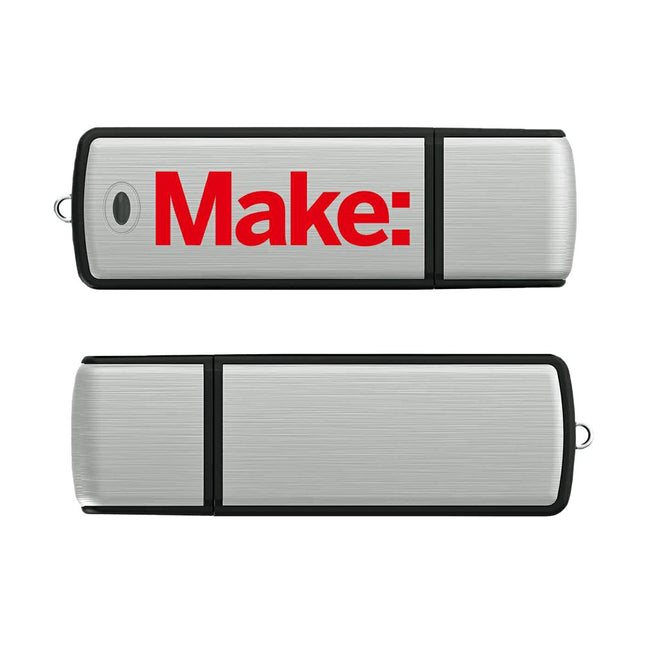
Elektor Classics Make Magazine 2020-2021 (USB-stick)
Het tijdschrift Make bevat bouwinstructies voor coole projecten (Arduino, Raspberry Pi en meer), die zowel door leken als gevorderden nagebouwd kunnen worden. Make laat niet alleen zien hoe het project werkt, maar publiceert ook basisartikelen, tutorials en informatieve reviews over bijvoorbeeld 3D-printers, oscilloscopen of soldeerbouten. Deze USB-stick bevat alle 10 gepubliceerde Make uitgaven van de jaargangen 2020 en 2021.
€ 49,95€ 19,95
Leden identiek
-
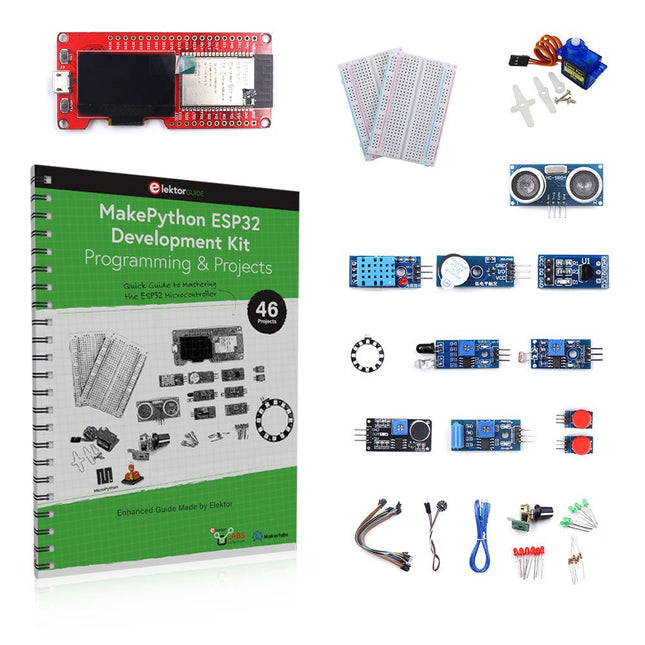
Elektor Bundles MakePython ESP32 Development Kit
Leer hoe je de ESP32 Microcontroller en het programmeren met MicroPython in je toekomstige projecten kunt gebruiken! Het (Engelstalige) projectboek, geschreven door de bekende Elektor auteur Dogan Ibrahim, bevat vele software- en hardware-gebaseerde projecten die speciaal voor de MakePython ESP32 ontwikkelkit ontwikkeld zijn. De kit wordt geleverd met verschillende LED's, sensoren, en actuatoren. De kit helpt je de basiskennis op te doen om eigen IoT projecten te maken. Alle volledig geëvalueerde projecten in het boek zijn voorzien van de bijgeleverde componenten. Elk project bevat een blokschema, een schakelschema, een volledige programmalijst, en een volledige programma beschrijving. Inbegrepen in de kit 1x MakePython ESP32 ontwikkelingsboard met LCD 1x Ultrasone afstandsmeter 1x Temperatuur- en luchtvochtigheidssensor 1x Zoemer module 1x DS18B20 module 1x Infrarood module 1x Potentiometer 1x WS2812 module 1x Geluidssensor 1x Trilsensor 1x Module met lichtgevoelige weerstand 1x Puls sensor 1x Servo motor 1x USB kabel 2x Knop 2x Breadboard 45x Schakeldraad 10x Weerstand 330R 10x LED (Rood) 10x LED (Groen) 1x Projectboek (Engelstalig, 206 pagina's) Boek met 46 projecten LED Projecten Knipperende LED SOS knipperende LED Knipperende LED – met behulp van een timer Afwisselend knipperende LEDs Knopbediening De knippersnelheid van de LED's veranderen met drukknop onderbrekingen Chasing-LEDs Binaire teller met LEDs Kerstverlichting (willekeurig-knipperende 8 LEDs) Elektronische dobbelsteen Geluksdag van het week Projecten voor Pulsewidth Modulation (PWM) Genereer een PWM golfvorm van 1000 Hz met 50% duty cycle LED helderheid regelen Meten van de frequentie en duty cycle van een PWM golfvorm Melodieën maker Eenvoudig elektronisch orgel Servo motor besturing Servo motor DS18B20 thermometer Projecten voor analoog naar digitaal converteren (ADC) Voltmeter Plotten van de analoge ingangsspanning Interne temperatuursensor van de ESP32 Ohmmeter Lichtgevoelige weerstandsmodule Projecten voor digitaal naar analoog converteren (DAC) Opwekken van vaste spanningen Opwekken van een zaagtand-golf signaal Opwekken van een driehoek-golf signaal Golfvorm met willekeurige periode Genereren van een sinus-golf signaal Genereren van een nauwkeurig sinus-golf signaal met behulp van een timer interrupts Gebruik van het OLED Display Seconden teller Gebeurtenisteller DS18B20 digitale thermometer met OLED ON-OFF temperatuur regelaar Meten van temperatuur en luchtvochtigheid Ultrasone afstandsmeting Hoogte van een persoon (stadiometer) Hartslag (polsslag) meten Andere bij de set geleverde sensoren Diefstal alarm Met geluid geactiveerd licht Infrarood obstakel-vermijding met zoemer WS2812 RGB LED ring Tijdregistratie van temperatuur en luchtvochtigheid Netwerkprogrammering Wi-Fi scanner Bediening op afstand vanuit de Internet browser (met een smartphone of PC) – Webserver Temperatuur- en luchtvochtigheidsgegevens opslaan in de Cloud Werking met Low-Power Gebruik een timer om de processor te laten ontwaken
-

Cytron MakerDisk M.2 SSD met voorgeïnstalleerd Raspberry Pi OS (128 GB)
Deze NVMe M.2 2242 SSD (128 GB) wordt vooraf geïnstalleerd met Raspberry Pi OS voor onmiddellijk gebruik met de Raspberry Pi 5 M.2 HAT+. Kenmerken Formfactor: M.2 2242 M-Key NVMe SSD Vooraf geladen met Raspberry Pi OS Hoge mate van vermogen om schokken, trillingen en hoge temperaturen te verdragen SMART TRIM-ondersteuning PCIe-interface: PCIe Gen3 x2 Compliance: NVMe 1.3, PCI Express Basis 3.1 Capaciteit: 128 GB Snelheid: Lezen: tot 1700 MB/s Schrijven: tot 600 MB/s Schok: 1500 G/0,5 ms Bedrijfstemperatuur: 0°C-70°C Tot 30x sneller dan een normale harde schijf Verhoogt de burst-schrijfprestaties, waardoor het ideaal is voor normale computerwerkbelastingen Sneller opstarten, afsluiten, applicatie laden en respons voor Raspberry Pi Downloads Datasheet
-
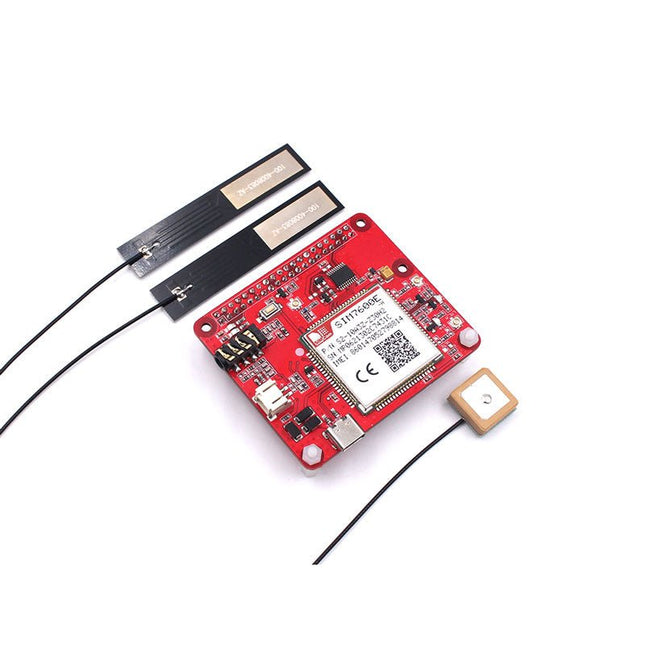
Makerfabs Makerfabs 4G LTE Hat voor Raspberry Pi
Gebruik je Raspberry Pi met LTE Cat-4 4G/3G/2G communicatie & GNSS plaatsbepaling, voor data transmissie/telefoon/SMS op afstand, geschikt voor het op afstand bewaken/alarmeren. Deze 4G Hat is gebaseerd op de Maduino Zero 4G LTE, maar zonder controller. Hij moet werken met de Raspberry Pi (2x20 connector en USB). De Raspberry Pi communiceert met deze Hat met behulp van AT commando's (via de TX/RX pinnen in de 2X20 connector) voor eenvoudige besturingen, zoals SMS/Phone/GNSS; met de USB aansluiting en de juiste Linux driver geïnstalleerd, fungeert de 4G hat als een 4G netwerkadapter, die toegang heeft tot het Internet en gegevens kan verzenden met het 4G protocol. Vergeleken met een gewone USB 4G dongle heeft deze Raspberry Pi 4G Hat de volgende voordelen: Onboard audio codec, zodat je rechtstreeks met je RPi kunt bellen, of automatisch met een luidspreker kunt meeluisteren; Hardware UART communicatie, hardware besturing van de stroomvoorziening (door 2s puls van PI GPIO of POWERKEY toets), hardware besturing van de flight mode; Twee antennes voor LTE 4G en een voor GPS Kenmerken LTE Cat-4, met uplink snelheid van 50 Mbps en downlink snelheid 150 Mbps GNSS Positionering Audio Driver NAU8810 Ondersteuning voor dial-up, phone, SMS, TCP, UDP, DTMF, HTTP, FTP, etcetera Ondersteuning voor GPS, BeiDou, Glonass, LBS base station positionering SIM card slot, ondersteuning voor 1.8V/3V SIM card Onboard audio jack en audio decoder voor het maken van een telefoongesprek 2x LED indicatoren, om de bedrijfstatus eenvouding te volgen Supports SIM application toolkit: SAT Class 3, GSM 11.14 Release 99, USAT Inbegrepen 1x 4G LTE Hat voor Raspberry Pi 1x GPS antenne 2x 4G LTE antenne 2x Afstandbussen Downloads GitHub
€ 99,95€ 49,95
Leden identiek
-
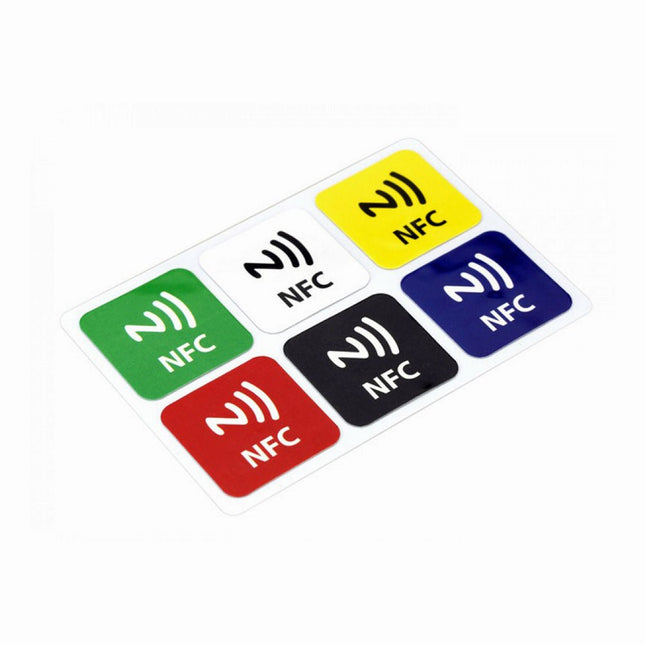
Makerfabs Makerfabs NFC Stickers (6 pcs)
Features NFC chip material: PET + Etching antenna Chip: NTAG216 (compatible with all NFC phones) Frequency: 13.56 MHz (High Frequency) Reading time: 1-2 ms Storage capacity: 888 bytes Read and write times: > 100,000 times Reading distance: 0-5 mm Data retention: > 10 years NFC chip size: Diameter 30 mm Non-contact, no friction, the failure rate is small, low maintenance costs Read rate, verification speed, which can effectively save time and improve efficiency Waterproof, dustproof, anti-vibration No power comes with an antenna, embedded encryption control logic, and communication logic circuit Included 1x NFC Stickers (6-color kit)
€ 9,95€ 4,95
Leden identiek
-

Makerfabs Makerfabs PN532 NFC Module V3
NFC is de laatste jaren een populaire technologie. Bijna alle high-end telefoons op de markt ondersteunen NFC. Near field communication (NFC) is een reeks standaarden voor smartphones en soortgelijke apparaten om radiocommunicatie met elkaar tot stand te brengen door ze tegen elkaar aan te raken of ze in elkaars nabijheid te brengen, meestal niet meer dan enkele centimeters. Deze module is gebouwd rond NXP PN532. NXP PN532 is zeer populair op het gebied van NFC. Makerfabs heeft deze module ontwikkeld op basis van het officiële document. Een bibliotheek voor deze module is beschikbaar. Features Kleine afmetingen en eenvoudig in te bouwen in uw project Ondersteunt I²C, SPI, en HSU (High-Speed UART), gemakkelijk om te schakelen tussen deze modi Ondersteunt RFID lezen en schrijven, P2P communicatie met peers, NFC met Android telefoon Tot 5 ~ 7 cm leesafstand On-board level shifter, standaard 5 V TTL voor I²C en UART, 3,3 V TTL SPI Arduino compatibel, plugin en spelen met ons schild RFID lezer / schrijver ondersteunt Mifare 1k, 4k, Ultralight, en DESFire kaarten ISO/IEC 14443-4 kaarten zoals CD97BX, CD light, Desfire, P5CN072 (SMX) Innovision Jewel-kaarten, zoals IRT5001-kaarten FeliCa-kaarten, zoals RCS_860 en RCS_854 Downloads Gebruik NFC Bibliotheek
-
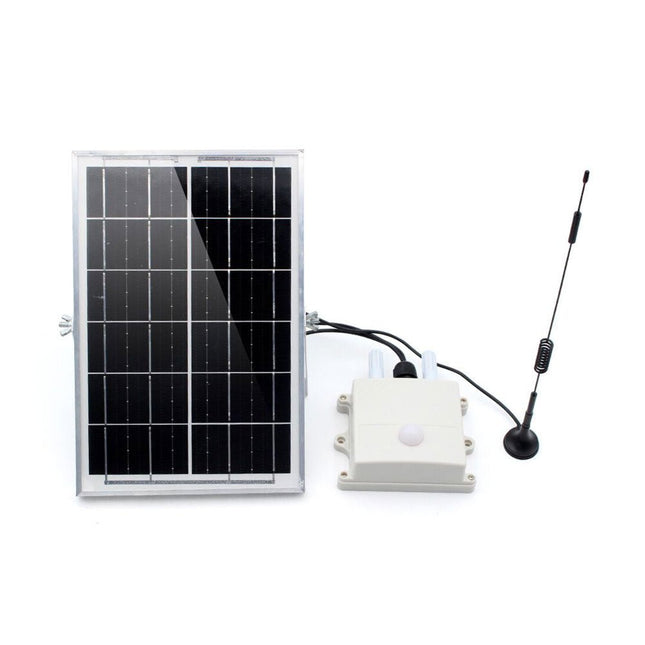
Makerfabs Makerfabs SenseLoRa Industrial-grade Air Monitor (EU868)
This air monitor is specifically used for monitoring greenhouses. It detects: Air temperature & Humidity CO2 concentration Light intensity Then transmit the data via LoRa P2P to the LoRa receiver (on your desk in the room) so that the user can monitor the field status or have it recorded for long-term analysis. This module monitors the greenhouse field status and sends all sensor data regularly via LoRa P2P in Jason format. This LoRa signal can be received by the Makerfabs LoRa receiver and thus displayed/recorded/analyzed on the PC. The monitoring name/data cycle can be set with a phone, so it can be easily implemented into the file. This air monitor is powered by an internal LiPo battery charged by a solar panel and can be used for at least 1 year with the default setting (cycle 1 hour). Features ESP32S3 module onboard with the WiFi and Bluetooth Ready to use: Power it on directly to use Module name/signal interval settable easily by phone IP68 water-proof Temperature: -40°C~80°C, ±0.3 Humidity: 0~100% moisture CO2: 0~1000 ppm Light intensity: 1-65535 lx Communication distance: Lora: >3 km 1000 mAh battery, charger IC onboard Solar panel 6 W, ensure system works Downloads Manual BH1750 Datasheet SGP30 Datasheet
€ 69,95€ 34,95
Leden identiek
-

STAEDTLER Permanent Markers for the EggBot (Pack of 6)
Universele pen voor gebruik op nagenoeg alle oppervlakken Geschikt voor OHP Ook geschikt om op CD's en DVD's te schrijven Excellente veegvastheid en waterbestendigheid op nagenoeg alle oppervlakken Droog na luttele seconden, daarom ook ideaal voor linkshandigen Permanente, nagenoeg geurloze inkt Lichtbestendige kleuren: zwart, bruin Zwart is weersbestendig Opstelbare STAEDTLER box PP lichaam en dop voor een lange levensduur DRY SAFE - kan dagenlang open liggen zonder uitdrogen (Test ISO 554) Airplane safe - automatische aanpassing van de druk voorkomt het lekken van de pen aan boord van een vliegtuig Zonder xyleen en tolueen Schitterende kleuren Ljnbreedte S - Superfijn (ca. 0.4 mm) Navulbaar
€ 10,95€ 5,50
Leden identiek
-
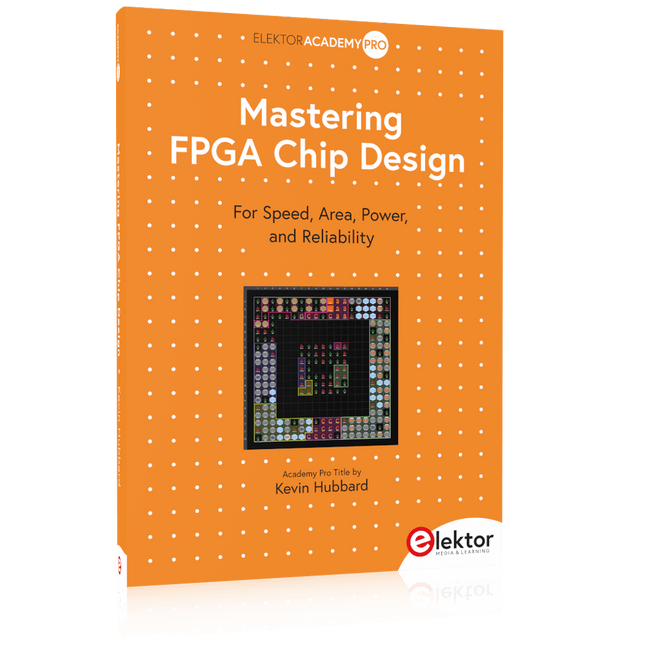
Elektor Publishing Mastering FPGA Chip Design
For Speed, Area, Power, and Reliability This book teaches the fundamentals of FPGA operation, covering basic CMOS transistor theory to designing digital FPGA chips using LUTs, flip-flops, and embedded memories. Ideal for electrical engineers aiming to design large digital chips using FPGA technology. Discover: The inner workings of FPGA architecture and functionality. Hardware Description Languages (HDL) like Verilog and VHDL. The EDA tool flow for converting HDL source into a functional FPGA chip design. Insider tips for reliable, low power, and high performance FPGA designs. Example designs include: Computer-to-FPGA UART serial communication. An open-source Sump3 logic analyzer implementation. A fully functional graphics controller. What you need: Digilent BASYS3 or similar FPGA eval board with an AMD/Xilinx FPGA. Vivado EDA tool suite (available for download from AMD website free of charge). Project source files available from author’s GitHub site.
€ 39,95
Leden € 35,96
-

Elektor Digital Mastering FPGA Chip Design (E-book)
For Speed, Area, Power, and Reliability This book teaches the fundamentals of FPGA operation, covering basic CMOS transistor theory to designing digital FPGA chips using LUTs, flip-flops, and embedded memories. Ideal for electrical engineers aiming to design large digital chips using FPGA technology. Discover: The inner workings of FPGA architecture and functionality. Hardware Description Languages (HDL) like Verilog and VHDL. The EDA tool flow for converting HDL source into a functional FPGA chip design. Insider tips for reliable, low power, and high performance FPGA designs. Example designs include: Computer-to-FPGA UART serial communication. An open-source Sump3 logic analyzer implementation. A fully functional graphics controller. What you need: Digilent BASYS3 or similar FPGA eval board with an AMD/Xilinx FPGA. Vivado EDA tool suite (available for download from AMD website free of charge). Project source files available from author’s GitHub site.
€ 32,95
Leden € 26,36
-
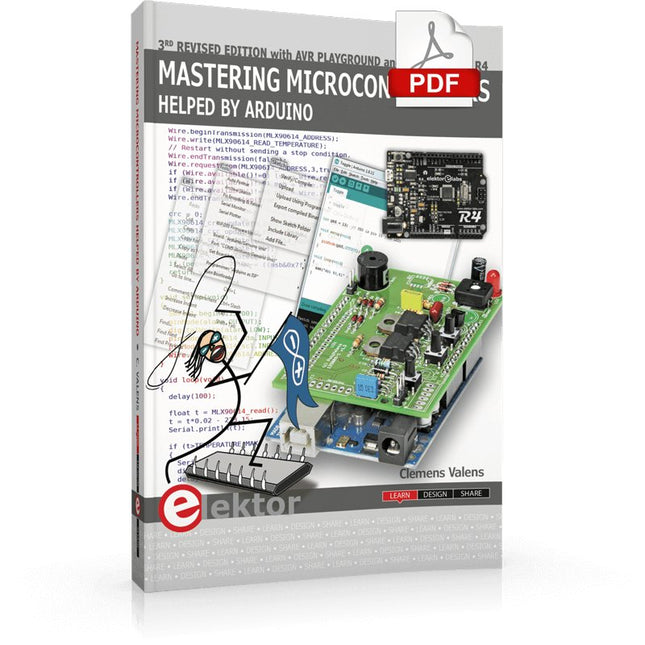
Elektor Digital Mastering Microcontrollers Helped by Arduino (3rd Edition) | E-book
Third, extended and revised edition with AVR Playground and Elektor Uno R4 Arduino boards have become hugely successful. They are simple to use and inexpensive. This book will not only familiarize you with the world of Arduino but it will also teach you how to program microcontrollers in general. In this book theory is put into practice on an Arduino board using the Arduino programming environment. Some hardware is developed too: a multi-purpose shield to build some of the experiments from the first 10 chapters on; the AVR Playground, a real Arduino-based microcontroller development board for comfortable application development, and the Elektor Uno R4, an Arduino Uno R3 on steroids. The author, an Elektor Expert, provides the reader with the basic theoretical knowledge necessary to program any microcontroller: inputs and outputs (analog and digital), interrupts, communication busses (RS-232, SPI, I²C, 1-wire, SMBus, etc.), timers, and much more. The programs and sketches presented in the book show how to use various common electronic components: matrix keyboards, displays (LED, alphanumeric and graphic color LCD), motors, sensors (temperature, pressure, humidity, sound, light, and infrared), rotary encoders, piezo buzzers, pushbuttons, relays, etc. This book will be your first book about microcontrollers with a happy ending! This book is for you if you are a beginner in microcontrollers, an Arduino user (hobbyist, tinkerer, artist, etc.) wishing to deepen your knowledge,an Electronics Graduate under Undergraduate student or a teacher looking for ideas. Thanks to Arduino the implementation of the presented concepts is simple and fun. Some of the proposed projects are very original: Money Game Misophone (a musical fork) Car GPS Scrambler Weather Station DCF77 Decoder Illegal Time Transmitter Infrared Remote Manipulator Annoying Sound Generator Italian Horn Alarm Overheating Detector PID Controller Data Logger SVG File Oscilloscope 6-Channel Voltmeter All projects and code examples in this book have been tried and tested on an Arduino Uno board. They should also work with the Arduino Mega and every other compatible board that exposes the Arduino shield extension connectors. Please note For this book, the author has designed a versatile printed circuit board that can be stacked on an Arduino board. The assembly can be used not only to try out many of the projects presented in this book but also allows for new exercises that in turn provide the opportunity to discover new techniques. Also available is a kit of parts including the PCB and all components. With this kit you can build most of the circuits described in the book and more. Datasheets Active Components Used (.PDF file): ATmega328 (Arduino Uno) ATmega2560 (Arduino Mega 2560) BC547 (bipolar transistor, chapters 7, 8, 9) BD139 (bipolar power transistor, chapter 10) BS170 (N-MOS transistor, chapter 8) DCF77 (receiver module, chapter 9) DS18B20 (temperature sensor, chapter 10) DS18S20 (temperature sensor, chapter 10) HP03S (pressure sensor, chapter 8) IRF630 (N-MOS power transistor, chapter 7) IRF9630 (P-MOS power transistor, chapter 7) LMC6464 (quad op-amp, chapter 7) MLX90614 (infrared sensor, chapter 10) SHT11 (humidity sensor, chapter 8) TS922 (dual op-amp, chapter 9) TSOP34836 (infrared receiver, chapter 9) TSOP1736 (infrared receiver, chapter 9) MPX4115 (analogue pressure sensor, chapter 11) MCCOG21605B6W-SPTLYI (I²C LCD, chapter 12) SST25VF016B (SPI EEPROM, chapter 13) About the author Clemens Valens, born in the Netherlands, lives in France since 1997. Manager at Elektor Labs and Webmaster of ElektorLabs, in love with electronics, he develops microcontroller systems for fun, and sometimes for his employer too. Polyglot—he is fluent in C, C++, PASCAL, BASIC and several assembler dialects—Clemens spends most of his time on his computer while his wife, their two children and two cats try to attract his attention (only the cats succeed). Visit the author’s website: www.polyvalens.com.Authentic testimony of Hervé M., one of the first readers of the book:'I almost cried with joy when this book made me understand things in only three sentences that seemed previously completely impenetrable.'
€ 34,95
Leden € 27,96
-

Elektor Digital Mastering Surface Mount Technology (E-book)
Mastering Surface Mount Technology takes you on a crash course in techniques, tips and know-how to successfully introduce surface mount technology in your workflow. Even if you are on a budget you too can jumpstart your designs with advanced fine pitch parts. Besides explaining methodology and equipment, attention is given to SMT parts technologies and soldering methods. In a step by step way, several projects introduce you to handling surface mount parts and the required skills to successfully build SMT assemblies. Many practical tips and tricks are disclosed that bring surface mount technology into everyone's reach without breaking the bank.
€ 34,95
Leden € 27,96
-
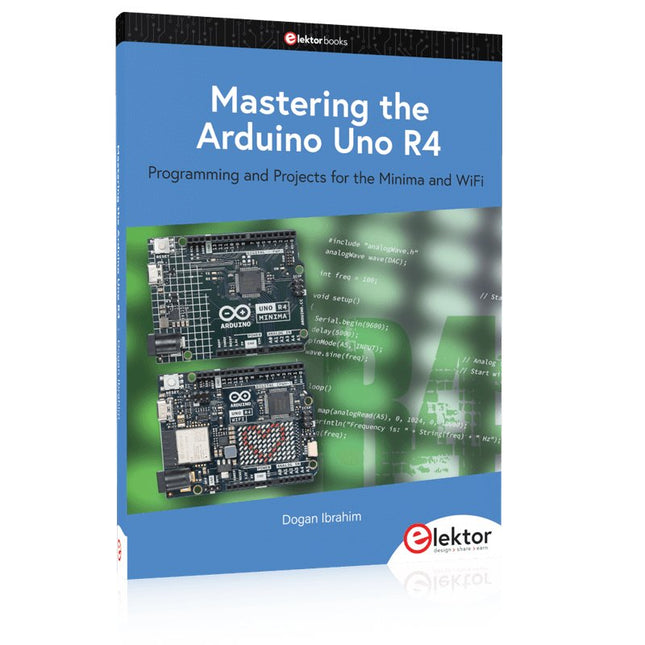
Elektor Publishing Mastering the Arduino Uno R4
Programming and Projects for the Minima and WiFi Based on the low-cost 8-bit ATmega328P processor, the Arduino Uno R3 board is likely to score as the most popular Arduino family member so far, and this workhorse has been with us for many years. Recently, the new Arduino Uno R4 was released, based on a 48-MHz, 32-bit Cortex-M4 processor with a huge amount of SRAM and flash memory. Additionally, a higher-precision ADC and a new DAC are added to the design. The new board also supports the CAN Bus with an interface. Two versions of the board are available: Uno R4 Minima, and Uno R4 WiFi. This book is about using these new boards to develop many different and interesting projects with just a handful of parts and external modules, which are available as a kit from Elektor. All projects described in the book have been fully tested on the Uno R4 Minima or the Uno R4 WiFi board, as appropriate. The project topics include the reading, control, and driving of many components and modules in the kit as well as on the relevant Uno R4 board, including LEDs 7-segment displays (using timer interrupts) LCDs Sensors RFID Reader 4×4 Keypad Real-time clock (RTC) Joystick 8×8 LED matrix Motors DAC (Digital-to-analog converter) LED matrix WiFi connectivity Serial UART CAN bus Infrared controller and receiver Simulators … all in creative and educational ways with the project operation and associated software explained in great detail.
€ 39,95
Leden € 35,96
-

Elektor Digital Mastering the Arduino Uno R4 (E-book)
Programming and Projects for the Minima and WiFi Based on the low-cost 8-bit ATmega328P processor, the Arduino Uno R3 board is likely to score as the most popular Arduino family member so far, and this workhorse has been with us for many years. Recently, the new Arduino Uno R4 was released, based on a 48-MHz, 32-bit Cortex-M4 processor with a huge amount of SRAM and flash memory. Additionally, a higher-precision ADC and a new DAC are added to the design. The new board also supports the CAN Bus with an interface. Two versions of the board are available: Uno R4 Minima, and Uno R4 WiFi. This book is about using these new boards to develop many different and interesting projects with just a handful of parts and external modules, which are available as a kit from Elektor. All projects described in the book have been fully tested on the Uno R4 Minima or the Uno R4 WiFi board, as appropriate. The project topics include the reading, control, and driving of many components and modules in the kit as well as on the relevant Uno R4 board, including LEDs 7-segment displays (using timer interrupts) LCDs Sensors RFID Reader 4×4 Keypad Real-time clock (RTC) Joystick 8×8 LED matrix Motors DAC (Digital-to-analog converter) LED matrix WiFi connectivity Serial UART CAN bus Infrared controller and receiver Simulators … all in creative and educational ways with the project operation and associated software explained in great detail.
€ 32,95
Leden € 26,36
-
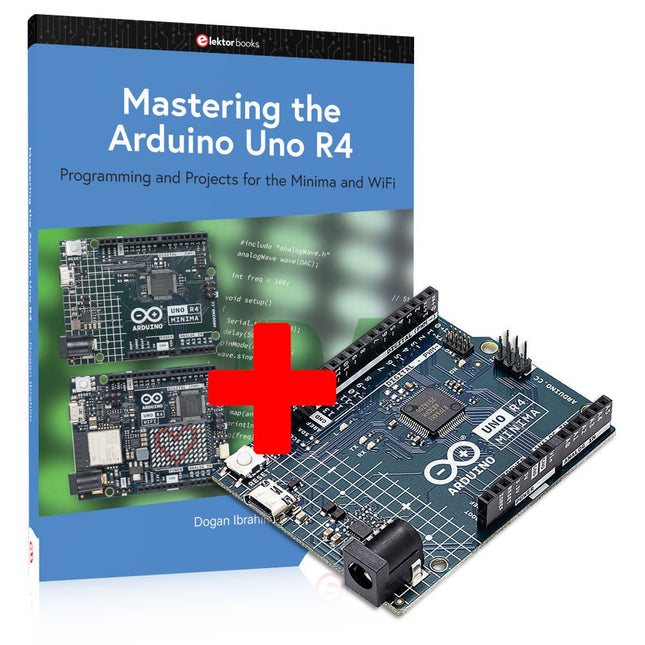
Elektor Bundles Mastering the Arduino Uno R4 Bundel
Mastering the Arduino Uno R4 Based on the low-cost 8-bit ATmega328P processor, the Arduino Uno R3 board is likely to score as the most popular Arduino family member so far, and this workhorse has been with us for many years. Recently, the new Arduino Uno R4 was released, based on a 48-MHz, 32-bit Cortex-M4 processor with a huge amount of SRAM and flash memory. Additionally, a higher-precision ADC and a new DAC are added to the design. The new board also supports the CAN Bus with an interface. Two versions of the board are available: Uno R4 Minima, and Uno R4 WiFi. This book is about using these new boards to develop many different and interesting projects with just a handful of parts and external modules, which are available as a kit from Elektor. All projects described in the book have been fully tested on the Uno R4 Minima or the Uno R4 WiFi board, as appropriate. The project topics include the reading, control, and driving of many components and modules in the kit as well as on the relevant Uno R4 board, including LEDs 7-segment displays (using timer interrupts) LCDs Sensors RFID Reader 4×4 Keypad Real-time clock (RTC) Joystick 8×8 LED matrix Motors DAC (Digital-to-analog converter) LED matrix WiFi connectivity Serial UART CAN bus Infrared controller and receiver Simulators … all in creative and educational ways with the project operation and associated software explained in great detail. Arduino Uno R4 Minima The Arduino Uno R4 is powered by the Renesas RA4M1 32-bit ARM Cortex-M4 processor, providing a significant boost in processing power, memory, and functionality. The WiFi version comes with an ESP32-S3 WiFi module in addition to the RA4M1, expanding creative opportunities for makers and engineers. The Uno R4 Minima is an affordable option for those who don't need the additional features. The Arduino Uno R4 runs at 48 MHz, which provides a 3x increase over the popular Uno R3. Additionally, SRAM has been upgraded from 2 kB to 32 kB, and flash memory from 32 kB to 256 kB to support more complex projects. Responding to community feedback, the USB port is now USB-C, and the maximum power supply voltage has been raised to 24 V with an enhanced thermal design. The board includes a CAN bus and an SPI port, enabling users to reduce wiring and perform parallel tasks by connecting multiple shields. A 12-bit analog DAC is also provided on the board. Specificaties Microcontroller Renesas RA4M1 (ARM Cortex-M4) USB USB-C Programming Port Pins Digital I/O Pins 14 Pins Analog input pins 6 DAC 1 PWM pins 6 Communication UART 1x I²C 1x SPI 1x CAN 1x CAN Bus Power Circuit operating voltage 5 V Input voltage (VIN) 6-24 V DC Current per I/O Pin 8 mA Clock speed Main core 48 MHz Memory RA4M1 256 kB Flash, 32 kB RAM Dimensions 68.9 x 53.4 mm Downloads Datasheet Schematics Deze bundel bevat: Mastering the Arduino Uno R4 (t.w.v. € 40) Arduino Uno R4 Minima (t.w.v. € 20)
-

Elektor Digital Mastering the I²C Bus (E-book)
Mastering the I²C Bus takes you on an exploratory journey of the I²C Bus and its applications. Besides the Bus protocol, plenty of attention is given to the practical applications and designing a stable system. The most common I²C compatible chip classes are covered in detail. Two experimentation boards are available that allow for rapid prototype development. These boards are completed by a USB to I²C probe and a software framework to control I²C devices from your computer. All samples programs can be downloaded from the 'Attachments/Downloads' section on this page. Projects built on Board 1: USB to I²C Interface, PCA 9534 Protected Input, PCA 9534 Protected Output, PCA 9553 PWM LED Controller, 24xxx EEPROM Module, LM75 Temperature Sensor, PCA8563 Real-time Clock with Battery Backup, LCD and Keyboard Module, Bus Power Supply. Projects built on Board 2: Protected Input, Protected Output, LM75 Temperature Sensor, PCF8574 I/O Board, SAA1064 LED Display, PCA9544 Bus Expander, MCP40D17 Potentiometer, PCF8591 AD/DA, ADC121 A/D Converter, MCP4725 D/A Converter, 24xxx EEPROM Module.
€ 34,95
Leden € 27,96
-

Makerfabs MaTouch ESP32-S3 Parallel TFT 3.5" Touch Display (ILI9488)
The ESP32-S3 Parallel TFT not only offers more SRAM and ROM (compared to the S2 version), but with Bluetooth 5.0 it is also suitable for applications such as local monitoring and controlling.The built-in LCD driver ILI9488 uses 16-bit parallel lines to communicate with ESP32-S3, the main clock can be up to 20 MHz, which makes the display smooth enough for video displays. With this display, you can create more IoT display projects.Features Controller: ESP32-S3-WROOM-1, PCB Antenna, 16 MB Flash, 2 MB PSRAM, ESP32-S3-WROOM-1-N16R2 Wireless: Wifi & Bluetooth 5.0 LCD: 3.5-inch TFT LCD Resolution: 480x320 Color: RGB LCD Interface: 16-bit parallel LCD Driver: ILI9488 Touch Panel: Capacitive Touch Panel Driver: FT6236 USB: Dual USB Type-C (one for USB-to-UART and one for native USB) UART to UART Chip: CP2104 Power Supply: USB Type-C 5.0 V (4.0 V~5.25 V) Button: Flash button and reset button Mabee Interface: 1x I²C, 1x GPIO Backlight Controller: Yes MicroSD: Yes Arduino support: Yes Type-C Power Delivery: Not supported Operation temperature: -40? to +85? Dimension: 66 x 84.3 x 12 mm Weight: 52 g Downloads ESP32-S3 Datasheet GitHub Wiki LVGL Demo Code
-

Makerfabs MaTouch ESP32-S3 Parallel TFT 7" Touch Display (1024x600)
This ESP32 S3 7-inch IPS 5-point capacitive touch display with an ultra-high resolution of 1024 x 600 pixels is ideal for IoT applications. It is ideal for applications such as home automation. An integrated SD card enables recording/playback of stored data. There are also two Mabee/Grove connectors to connect various sensors to this board to create personal prototype projects in no time. Specifications Controller: ESP32-S3-WROOM-1, PCB antenna, 16 MB Flash, 8 MB PSRAM, ESP32-S3-WROOM-1-N16R8 Wireless: Wifi & Bluetooth 5.0 LCD: 7-inch High Lightness IPS FPS: >30 Resolution: 1024 x 600 LCD interface: RGB 565 Touch panel: Capacitive 5-point touch Touch panel driver: GT911 USB: Dual USB-C (one for USB-to-UART and one for native USB) UART to UART chip: CP2104 Power supply: USB-C 5.0 V (4.0 V~5.25 V) Button: Flash button and reset button Mabee interface: 1x I²C, 1x GPIO MicroSD: Yes Arduino support: Yes Type-C Power Delivery: Not supported Operation temperature: ?40 to +85°C Downloads Wiki GitHub ESP32-S3 Datasheet Screen touch coordinates calibration
-
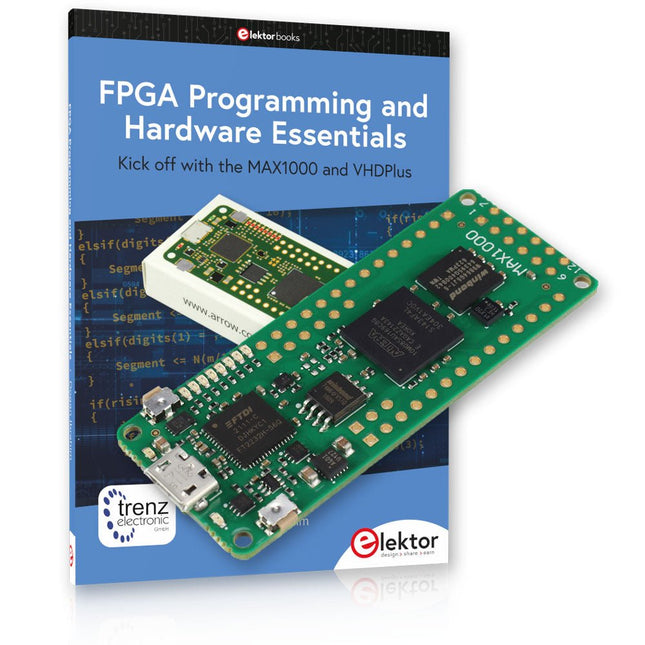
Elektor Bundles MAX1000 FPGA Programming Bundel
Begin met FPGA-programmering met het MAX1000-bord en VHDPlus Bent u klaar om FPGA-programmeren onder de knie te krijgen? Met deze bundel duikt u in de wereld van Field-Programmable Gate Arrays (FPGA's) – een configureerbaar geïntegreerd circuit dat na productie kan worden geprogrammeerd. Breng uw ideeën nu tot leven, van eenvoudige projecten tot complete microcontrollersystemen! De MAX1000 is een compact en krachtig FPGA-ontwikkelbord boordevol functies zoals geheugen, gebruikers-LED's, drukknoppen en flexibele I/O-poorten. Het is het ideale startpunt voor iedereen die meer wil weten over FPGA's en Hardware Definition Languages (HDL's). Met het bijgevoegde boek "FPGA Programming and Hardware Essentials" gaat u aan de slag met de programmeertaal VHDPlus – een eenvoudigere versie van VHDL. Je werkt aan praktische projecten met behulp van de MAX1000, waardoor je de vaardigheden en het vertrouwen krijgt om je creativiteit de vrije loop te laten. Projecten in het boek Arduino-aangedreven BCD naar 7-segment displaydecoder Gebruik een Arduino Uno R4 om BCD-gegevens aan de decoder te leveren, tel van 0 tot 9 met een vertraging van één seconde Gemultiplexte 4-cijferige gebeurtenisteller Maak een gebeurtenissenteller die het totale aantal weergeeft op een display van vier cijfers, dat bij elke druk op de knop wordt verhoogd PWM-golfvorm met vaste werkcyclus Genereer een PWM-golfvorm op 1 kHz met een vaste werkcyclus van 50% Ultrasone afstandsmeting Meet afstanden met behulp van een ultrasone sensor en geef de resultaten weer op een 4-cijferige LED met 7 segmenten Elektronisch slot Bouw een eenvoudig elektronisch slot met behulp van logische combinatiepoorten met drukknoppen en een LED-uitgang Temperatuursensor Bewaak de omgevingstemperatuur met een TMP36-sensor en geef de meetwaarden weer op een LED met 7 segmenten MAX1000 FPGA Development Board De MAX1000 is een aanpasbaar IoT/Maker Board, klaar voor evaluatie, ontwikkeling en/of gebruik in een product. Het is gebouwd rond de Intel MAX10 FPGA, het eerste niet-vluchtige programmeerbare logische apparaat (PLD's) met één chip in de sector dat de optimale set systeemcomponenten integreert. Gebruikers kunnen nu profiteren van de kracht van enorme herconfigureerbaarheid in combinatie met een krachtig FPGA-systeem met laag vermogen. MAX10-apparaten bieden intern opgeslagen dubbele beelden met zelfconfiguratie, uitgebreide ontwerpbeschermingsfuncties, geïntegreerde ADC's en hardware om de Nios II 32-bit microcontroller IP te implementeren en zijn de ideale oplossing voor systeembeheer, protocolbridging, communicatiecontrolevlakken, industriële, automobiel- en consumententoepassingen. De MAX1000 is uitgerust met een Arrow USB Programmer2, SDRAM, flashgeheugen, accelerometersensor en PMOD/Arduino MKR-connectoren, waardoor het een volledig functionele plug-and-play-oplossing is zonder extra kosten. Specificaties MAX 10 8kLE - Flash Dubbele binnenkant -ADC 8x 12-bits - Temperatuurbereik 0~85°C - Aanbod USB/pinnen SDRAM 8 MB MEMS met 3 assen LIS3DH USB-programmer aan boord MEMS-oscillator 12 MHz Schakelaar/LED 2x / 8x Inhoud van de bundel Boek: FPGA Programming and Hardware Essentials (normale prijs: € 40) MAX1000 FPGA Development Board (normale prijs: € 45) Downloads Software
-

Elektor Labs MAX7219 Dot Matrix Module (Set of 8)
Wegrollend tekstdisplay met acht 8 x 8 LED dot matrix displays (512 LEDs in totaal). Gebouwd rond een ESP-12F Wi-Fi module (ESP8266-gebaseerd), geprogrammeerd in de Arduino IDE. ESP8266 webserver maakt controle mogelijk van weergegeven tekst, scroll vertraging en helderheid met een mobiele telefoon of ander Wi-Fi-verbonden (draagbaar) apparaat. Features 10 MHz seriële interface Individuele LED Segment Controle Decode/No-Decode Cijfer Selectie 150 µA laag-vermogen uitschakeling (gegevens blijven bewaard) Digitale en analoge helderheidsregeling Display blanked bij inschakelen Drive Common-Cathode LED Display Slew-Rate Limited Segment Drivers voor lagere EMI (MAX7221) SPI, QSPI, MICROWIRE seriële interface (MAX7221) 24-pins DIP- en SO-pakketten Note: De kale printplaat voor het Scrolling Message Display (160491-1) wordt apart verkocht.
€ 19,95€ 9,95
Leden identiek
-

Elektor Digital Meettechniek in de praktijk (E-book)
Meten is voor een praktiserend elektronicus even vanzelfsprekend als ademhalen. Of het nu om het ontwikkelen van nieuwe schakelingen gaat, de controle van elektronische apparaten tijdens de productiefase of om het foutzoeken in defecte apparatuur: meetapparaten zijn het belangrijkste gereedschap en worden voortdurend gebruikt. 'Weet wat je meet', luidt een bekende uitspraak. En zo is het maar net: om zichzelf geen rad voor ogen te draaien moet de elektronicus weten wat hij doet, moet hij de nauwkeurigheid van zijn meetapparatuur en vooral de voor- en nadelen van de toegepaste meetmethode kennen. En hier steekt dit boek de lezer de helpende hand toe: uitgaand van theoretische beschouwingen en definities van de belangrijkste begrippen van de meettechniek begeleidt het de lezer bij de reis van eenvoudige wijzerinstrumenten via multimeter en oscilloscoop tot en met FFT-analyzers en gespecialiseerde meetapparaten zoals audio-analyzers, geluidsdrukmeters, apparaat- en installatietesters.
€ 29,95
Leden € 23,96
-

KLOSE Mendocino Mendocino Motor AR O-8
The Mendocino Motor AR O-8 is a magnetically levitated, solar powered electric motor as a kit. Light Becomes Movement The solar-powered Mendocino motor seems to float in the air. At first glance, you can't see why the rotor is turning at all. This is the magic of the motor. The Lorentz force is a very small electrical force. In a classroom setting, it is detected by a current swing in the magnetic field. With the Mendocino motor, we have succeeded in developing a beautiful application that uses this weak force for propulsion. Due to its concealed base magnet, the motor will fascinate technically inclined observers. In bright sunlight, the motor can reach a speed of up to 1,000 rpm. More impressive, however, is that even the faint glow of an ample tea light (D = 6 cm with a flame height of about 2 cm) is sufficient to drive the motor. The motor is not yet an alternative source of energy, even though it looks tempting. Presumably, it will remain an attractive model until a resourceful mind disproves this assumption. Dimensions All solar cells 65 x 20 mm Mirror diameter: 25 mm Rotor weight: approx. 150 g Model length: 160 mm Model width: 85 mm Frame height: approx. 85 mm Frame material: black acrylic Tube made of highly polished aluminum Mirror color: silver The Mendocino motor’s easy-to-follow instruction manual includes more than 70 illustrations. It describes a safe and practical approach to construction but also gives you the freedom to try your solutions. Partly Pre-Assembled Kit A portion of the kit comes pre-assembled. Bonding the borosilicate glass pane to the acrylic surface requires specialized knowledge and aids. We do not want to impose this on the hobbyist. For instance, the base magnet is attached to the aluminum tube. As a hobbyist, you will need some know-how and appropriate tools: carpet knife, soldering iron and tin, hot glue, pliers, and a clamp or ferrule to fix the supplied assembly aid. A lot of fun is guaranteed!
-

Elektor Digital Meten en regelen via Android (E-BOOK)
Hebt u altijd al uw elektronicaproject willen aansturen vanuiteen kleurrijke app op een Android smartphone of tablet? Dat is mogelijk met het in dit boek beschreven Android I/O-board. Met de bijbehorende software-library kunt u in Android Studio eenvoudig zelf een app programmeren die dit mogelijk maakt.Het Android I/O-board (los verkrijgbaar, wordt niet met boek meegeleverd!) bezit 22 pennen die u vanuit een app kunt aansturen als digitale I/O, ADC, PWM, touch-sensing en counter. Het Android I/O-board kan met de Android smartphone communiceren via Bluetooth, WiFi of USB. Het board is ook als datalogger te gebruiken. Kortom, dit is een veelzijdig board dat in ieder project past.Dit boek beschrijft stap voor stap hoe u uw project tot een succes kunt maken. Het boek behandelt gestructureerd de volgende onderwerpen:• Een snelle handleiding hoe u uw Android I/O-board up and running krijgt.• Een uitleg van alle mogelijkheden van het Android I/Oboard, met uitgebreide voorbeelden bij de verschillende opties.• Een stap-voor-stap handleiding hoe u een app kunt programmeren in Android Studio.• Een beschrijving van de firmware op het Android I/O-board en hoe u dit zelf met MPLAB-X kunt aanpassen.• Voorbeeld-projecten om inspiratie op te doen hoe u uw eigen project kunt aansturen met het Android I/O-board.Alle software in dit boek is als gratis download beschikbaar.
€ 34,95
Leden € 27,96
-

Microchip Microchip AVR-IoT WA Development Board
The AVR-IoT WA development board combines a powerful ATmega4808 AVR MCU, an ATECC608A CryptoAuthentication™ secure element IC and the fully certified ATWINC1510 Wi-Fi network controller – which provides the most simple and effective way to connect your embedded application to Amazon Web Services (AWS). The board also includes an on-board debugger, and requires no external hardware to program and debug the MCU.Out of the box, the MCU comes preloaded with a firmware image that enables you to quickly connect and send data to the AWS platform using the on-board temperature and light sensors. Once you are ready to build your own custom design, you can easily generate code using the free software libraries in Atmel START or MPLAB Code Configurator (MCC).The AVR-IoT WA board is supported by two award-winning Integrated Development Environments (IDEs) – Atmel Studio and Microchip MPLAB X IDE – giving you the freedom to innovate with your environment of choice.Features ATmega4808 microcontroller Four user LED’s Two mechanical buttons mikroBUS header footprint TEMT6000 Light sensor MCP9808 Temperature sensor ATECC608A CryptoAuthentication™ device WINC1510 WiFi Module On-board Debugger Auto-ID for board identification in Atmel Studio and Microchip MPLAB X One green board power and status LED Programming and debugging Virtual COM port (CDC) Two DGI GPIO lines USB and battery powered Integrated Li-Ion/LiPo battery charger
€ 39,95€ 19,95
Leden identiek























